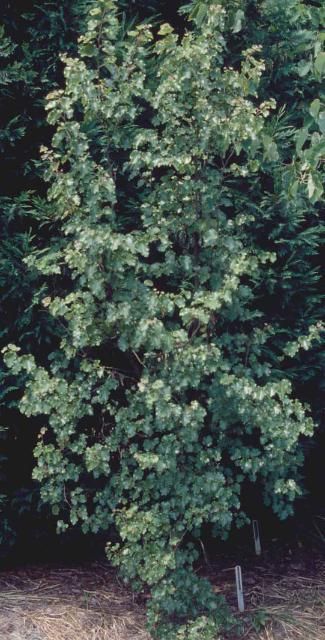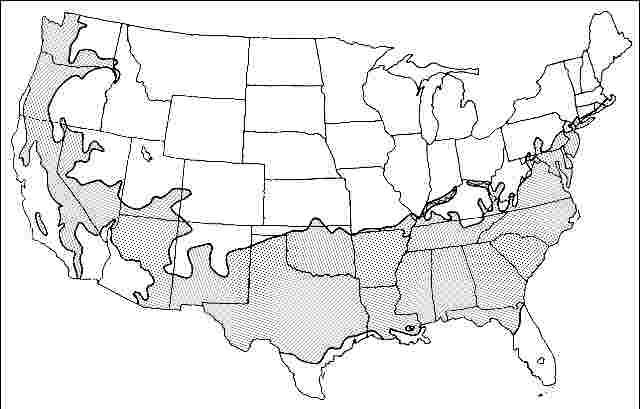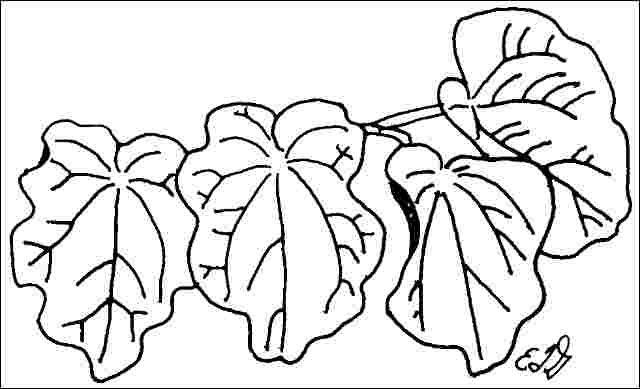Introduction
Mexican redbud is a moderate to rapid grower when young, reaching a height of 18 to 25 feet. The splendid purple-pink flowers appear all over the tree in spring, just before the leaves emerge. Leaves are considerably smaller than those on Texas redbud and eastern redbud, and the edges are distinctly undulating. Mexican redbud has an irregular growth habit when young but forms a graceful flat-topped vase-shape as it gets older. The tree usually branches low on the trunk, and if left intact forms a graceful multi-trunked habit. It and Texas redbud are the best-suited redbuds for western and central Texas and Oklahoma.

Credit: Ed Gilman, UF/IFAS
General Information
Scientific name: Cercis mexicana
Pronunciation: SER-sis meck-sih-KAY-nuh
Common name(s): Mexican redbud
Family: Leguminosae
USDA hardiness zones: 6B through 8B (Fig. 2)
Origin: native to North America
Invasive potential: little invasive potential
Uses: tree lawn 3–4 feet wide; tree lawn 4–6 feet wide; tree lawn > 6 ft wide; sidewalk cutout (tree pit); parking lot island < 100 sq ft; parking lot island 100–200 sq ft; parking lot island > 200 sq ft; deck or patio; shade; specimen; reclamation; highway median; container or planter; street without sidewalk
Availability: somewhat available, may have to go out of the region to find the tree

Description
Height: 18 to 25 feet
Spread: 18 to 25 feet
Crown uniformity: irregular
Crown shape: round, vase
Crown density: open
Growth rate: slow
Texture: coarse
Foliage
Leaf arrangement: alternate (Fig. 3)
Leaf type: simple
Leaf margin: entire, undulate
Leaf shape: orbiculate, ovate, cordate
Leaf venation: palmate, reticulate
Leaf type and persistence: deciduous
Leaf blade length: 2 to 4 inches
Leaf color: green
Fall color: yellow
Fall characteristic: showy

Flower
Flower color: pink
Flower characteristics: very showy
Fruit
Fruit shape: pod or pod-like
Fruit length: 1 to 3 inches
Fruit covering: dry or hard
Fruit color: brown
Fruit characteristics: attracts birds; showy; fruit/leaves not a litter problem
Trunk and Branches
Trunk/bark/branches: branches droop; not showy; can be trained to one trunk; thorns
Pruning requirement: needed for strong structure
Breakage: susceptible to breakage
Current year twig color: brown
Current year twig thickness: medium
Wood specific gravity: unknown
Culture
Light requirement: full sun, partial sun or partial shade
Soil tolerances: clay; sand; loam; alkaline; acidic; well-drained
Drought tolerance: high
Aerosol salt tolerance: none
Other
Roots: not a problem
Winter interest: no
Outstanding tree: yes
Ozone sensitivity: unknown
Verticillium wilt susceptibility: susceptible
Pest resistance: resistant to pests/diseases
Use and Management
Be sure to avoid weak forks by pruning to reduce the size of lateral branches and save those that form a U-shaped crotch, not a V. Keep them less than half the diameter of the main trunk to increase longevity of the tree. Do not allow multiple trunks to grow with tight crotches, instead space branches about 6 to 10 inches apart along a main trunk. Yellow (although somewhat variable and unreliable) fall color and tolerance to partial shade make this a suitable, attractive tree for understory or specimen planting. Best not used extensively as a street tree due to low disease resistance and short life, but is nice in commercial and residential landscapes. Plant in a shrub border for a spring and fall color display.
Mexican redbuds grow well in full sun in the northern part of its range but can benefit from some shade in the southern zones, particularly in the lower Midwest where summers are hot. Best growth occurs in a light, rich, moist soil but it adapts well to a variety of soil including sandy or alkaline. It grows well in its native habitat on limestones soils. Trees look better when they receive some irrigation in summer dry spells, especially if they are located in a restricted soil space. Trees are sold as single or multi-stemmed. Young trees are easiest to transplant and survive best when planted in the spring or fall. Containerized trees can be planted anytime. The beans provide food for some birds. Trees are often short-lived but provide a wonderful show in the spring and fall.
Cercis are best propagated by seed. Use ripe seed to plant directly, or, if seed has been stored, stratification is necessary before sowing in a greenhouse. Cultivars can be propagated by grafting onto seedlings, or by summer cuttings under mist or in a greenhouse.
Pests
Borers attack the trunk of older and stressed redbuds. Keep the plant vigorous.
Scale insects can usually be controlled with horticultural sprays.
Webworm can defoliate parts of the tree in summer and fall.
Diseases
Canker is the biggest problem with redbud. Dieback begins as a canker on a branch. The cankers, at first small and sunken, enlarge to girdle the branch. Bark in the canker turns black and a crack forms between diseased and healthy bark. The fungus enters through wounds or dead and dying branches. Once girdled, the part of the stem beyond the canker wilts and dies. There is no chemical control. Prune out diseased branches.
Leaf spots can be a problem during wet weather. Since the disease is rarely serious, no chemical controls are suggested.
Verticillium wilt attacks and kills redbud.